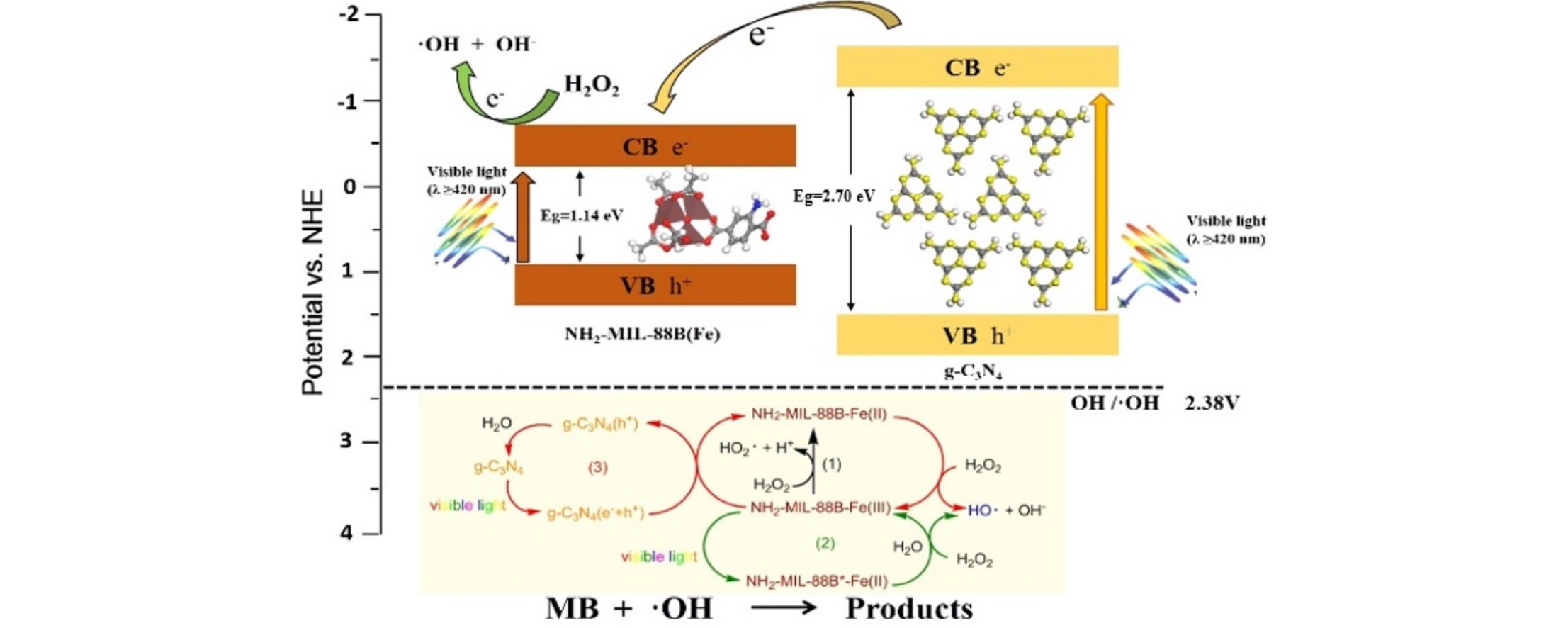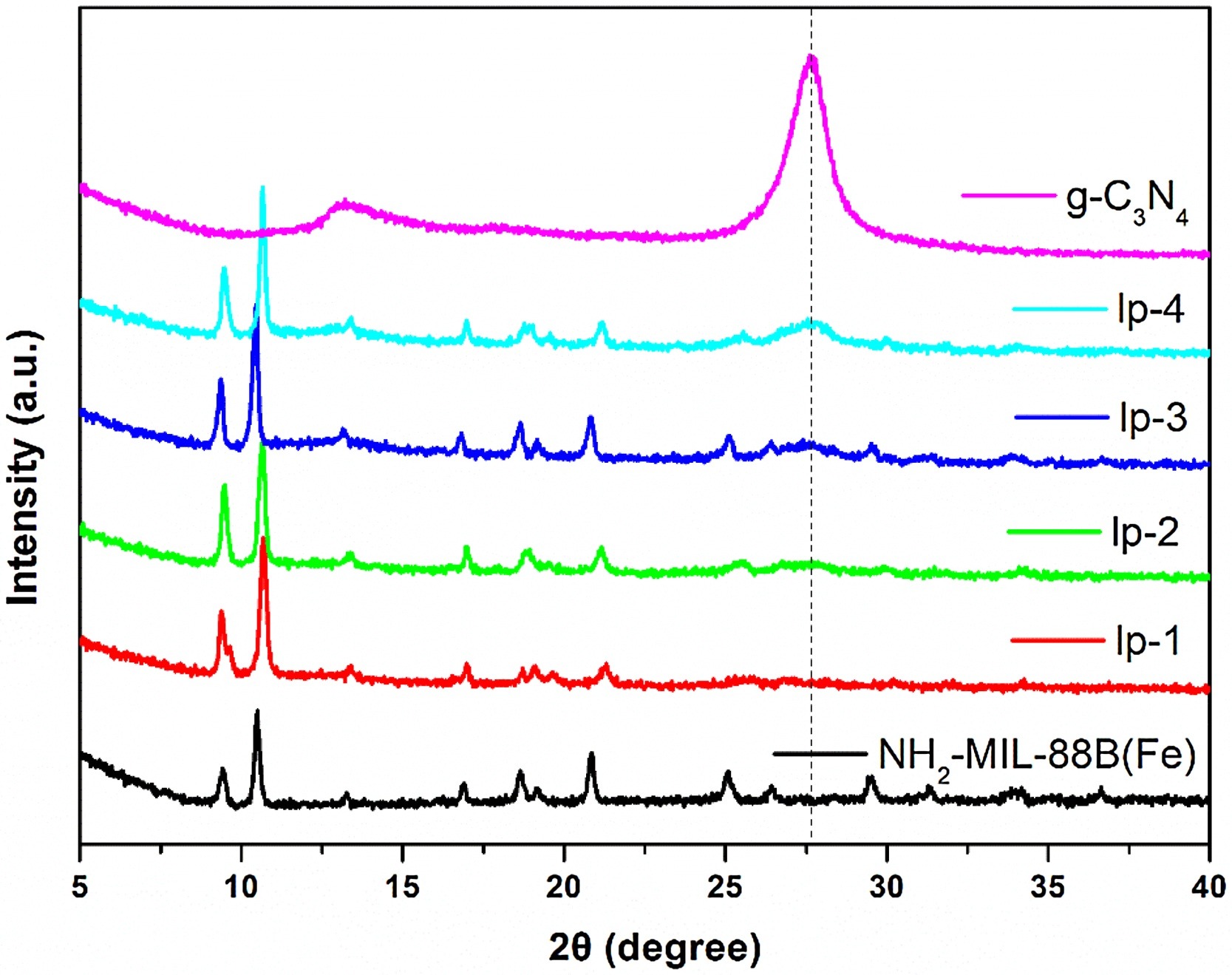Home >
News > Facilitation of the visible light-induced Fenton-like excitation of H₂O₂ via heterojunction of g-C₃N₄/NH₂-Iron terephthalate metal-organic framework for MB degradation
Facilitation of the visible light-induced Fenton-like excitation of H₂O₂ via heterojunction of g-C₃N₄/NH₂-Iron terephthalate metal-organic framework for MB degradation
Summary:
The authors from South China University of Technology developed g-C₃N₄/NH₂-MIL-88B(Fe) heterojunction materials (lp-x composites) with efficient visible light-induced Fenton-like activity, high stability, and strong synergistic effect, achieving 100% degradation of methylene blue (MB) in 120 minutes in the field of organic pollutant degradation.

Background:
1. To address the problems of rigorous pH range, long operation time, and low efficiency in traditional Fenton-like reactions, previous researchers developed Fe-based metal-organic frameworks (MOFs) and g-C₃N₄ as photocatalysts. However, their individual activities are limited due to high electron-hole recombination rates and insufficient activation of H₂O₂.
2. The authors proposed an innovative method by constructing a heterojunction between g-C₃N₄ and NH₂-MIL-88B(Fe) via solvothermal synthesis, which facilitates photo-induced electron transfer, enhances H₂O₂ activation, and significantly improves photocatalytic performance.
Research Content:
1. Synthesis:
The authors synthesized g-C₃N₄ by calcining melamine at 550°C for 4 hours. NH₂-MIL-88B(Fe) was prepared via solvothermal method using FeCl₃, 2-aminoterephthalic acid, and DMF at 150°C for 3 days. The g-C₃N₄/NH₂-MIL-88B(Fe) heterojunctions (lp-x composites) were obtained by adding g-C₃N₄ during the solvothermal synthesis of NH₂-MIL-88B(Fe), where x represents the mass fraction of g-C₃N₄ (lp-2 with 10% g-C₃N₄ showed optimal performance).
2. Characterizations:
1) BET and pore size distribution: Not explicitly provided, but XRD confirmed the preservation of both g-C₃N₄ (peak at 27.2°) and NH₂-MIL-88B(Fe) frameworks in lp-x.
2) SEM/TEM tests show the particle size of the material: NH₂-MIL-88B(Fe) is spindle-shaped with a length of ~0.9 μm; g-C₃N₄ is lamellar nanosheets; lp-2 shows g-C₃N₄ nanosheets embedded in spindle-shaped NH₂-MIL-88B(Fe), forming a heterojunction.
3) Other tests: UV-vis DRS indicates band gaps of 1.14 eV (NH₂-MIL-88B(Fe)) and 2.70 eV (g-C₃N₄); XPS confirms Fe-N interactions and electron transfer; PL spectra show reduced electron-hole recombination in lp-x; ESR proves enhanced ·OH generation in lp-2/H₂O₂ system.
3. Application:
The material was tested in MB degradation and cyclic stability:
- lp-2 degraded 100% of MB in 120 minutes under visible light, which is 2 times and 4 times higher than NH₂-MIL-88B(Fe) and g-C₃N₄ alone, respectively.
- The synergistic index (SI) of lp-2/visible light/H₂O₂ system reached 305%.
- lp-2 maintained high activity after 4 cyclic uses, with stable crystal structure confirmed by XRD.
- It also degraded colorless salicylic acid, ruling out photosensitization effects.
4. Mechanism:
The enhanced performance is attributed to the heterojunction facilitating electron transfer:
- Under visible light, electrons in g-C₃N₄'s conduction band (CB) transfer to NH₂-MIL-88B(Fe)'s CB, reducing electron-hole recombination.
- Transferred electrons promote Fe³⁺ → Fe²⁺ in NH₂-MIL-88B(Fe), activating H₂O₂ via Fenton-like reactions to generate ·OH (confirmed by ESR).
- Two pathways contribute: direct Fenton-like activation of H₂O₂ by Fe ions, and photo-induced electron-driven activation enhanced by the heterojunction.

Outlook:
This research realizes efficient visible light-induced Fenton-like reactions via g-C₃N₄/MOF heterojunctions, providing a new strategy for designing high-performance photocatalysts. The excellent stability and synergistic effect of lp-x composites promote their practical application in wastewater treatment, and shed light on hybridizing MOFs with semiconductors for advanced oxidation processes.
Facilitation of the visible light-induced Fenton-like excitation of H₂O₂ via heterojunction of g-C₃N₄/NH₂-Iron terephthalate metal-organic framework for MB degradation
Authors: Xiyi Li, Yunhong Pi, Liqiong Wu, Qibin Xia, Junliang Wu, Zhong Li, Jing Xiao
DOI: 10.1016/j.apcatb.2016.09.073
Link: https://www.sciencedirect.com/science/article/pii/S0926337316307615
The above review is for academic progress sharing. For any errors or copyright issues, please contact us for correction or removal.

